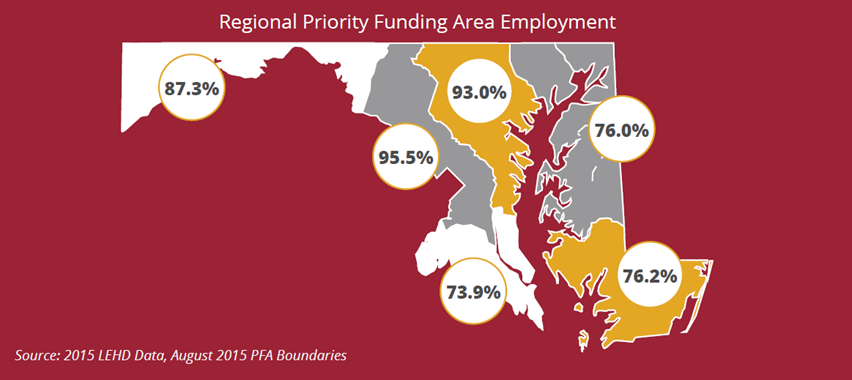Improving Economic Growth and Development in Existing Communities
Page Content
Focusing resources and partnering with the private sector to encourage revitalization of our existing
communities, whether urban, rural, or suburban.
At the heart of smart growth, for which Maryland is a leader, is dedication to the success of existing
communities. Not only does this yield benefits in Maryland’s historic towns, it also supports the
agricultural economy and protects our natural resources. Housing’s Sustainable Communities program,
Commerce’s Enterprise Zones, and the new federal Opportunity Zones are just a few of the spatial
designations aiding the economic growth and revitalization of Maryland’s existing communities.
Recognizing that the local context of economic development in Maryland’s existing communities is
essential, as is applying statewide resources and collaborating in creative ways, A Better Maryland
complements existing place-based programs and connects local change agents with potential partners
at every level. Leveraging layered incentives associated with spatial designations, adding in targeted
data, revitalization tools and allies, these strategies can accelerate and maintain the employment base
and community investment serving as the foundation of the state’s economy.

The Strategies
EC 1: Increase interagency engagement with private
sector economic development groups, such as
the Maryland Economic Development Association,
Chamber of Commerce, Urban Land Institute,
BWI Business Partnership, etc., in planning and
implementation.
Timeline
2020
Years 0-2
Years 2-4
Years 4-6
2026
EC 2: Promote state level resources and programs for
leveraging investment in Maryland’s federally designated
Opportunity Zones.
Timeline
2020
Years 0-2
Years 2-4
Years 4-6
2026
EC 3: Assist local jurisdictions with interagency
collaboration on local economic impact analyses
and technical assistance on best practices, when
requested.
Timeline
2020
Years 0-2
Years 2-4
Years 4-6
2026
EC 4: Explore strategies for integrating Labor’s and
DHCD’s data and online resources to assist state
and local community development planning and
programming.
Timeline
2020
Years 0-2
Years 2-4
Years 4-6
2026
EC 5: Develop economic development tools and services
to provide sub-county economic data and analysis
capabilities to assist local jurisdictions in grant
applications, programming and planning.
Timeline
2020
Years 0-2
Years 2-4
Years 4-6
2026
EC 6: Support and promote agricultural and other
resource-based (e.g., fishing and forestry)
businesses based on regional needs and demands
(e.g., Buy Local program and the Maryland
Outdoor Recreation Economic Commission
recommendations.)
Timeline
2020
Years 0-2
Years 2-4
Years 4-6
2026
EC 7: Assess healthcare needs and facilities statewide
to inform local planning and enhance community
development.
Timeline
2020
Years 0-2
Years 2-4
Years 4-6
2026
EC 8: Engage a broader range of people in education, training and professional development
opportunities related to planning and community development.
Timeline
2020
Years 0-2
Years 2-4
Years 4-6
2026
EC 9: Building upon Labor’s and DHCD’s experience and networks, enhance state’s resources for
and support to nonprofit community development corporations.
Timeline
2020
Years 0-2
Years 2-4
Years 4-6
2026
EC 10: Explore ways to expand, enhance and promote community development resources for
local governments, such as the town manager circuit rider program.
Timeline
2020
Years 0-2
Years 2-4
Years 4-6
2026
EC 11: Conduct regional business training events to inform and educate businesses and local
governments of the processes and opportunities to conduct business with state partners.
Timeline
2020
Years 0-2
Years 2-4
Years 4-6
2026
EC 12: Investigate the potential for collaboration with local government to expand cooperative
purchasing agreements.
Timeline
2020
Years 0-2
Years 2-4
Years 4-6
2026
Center_Content